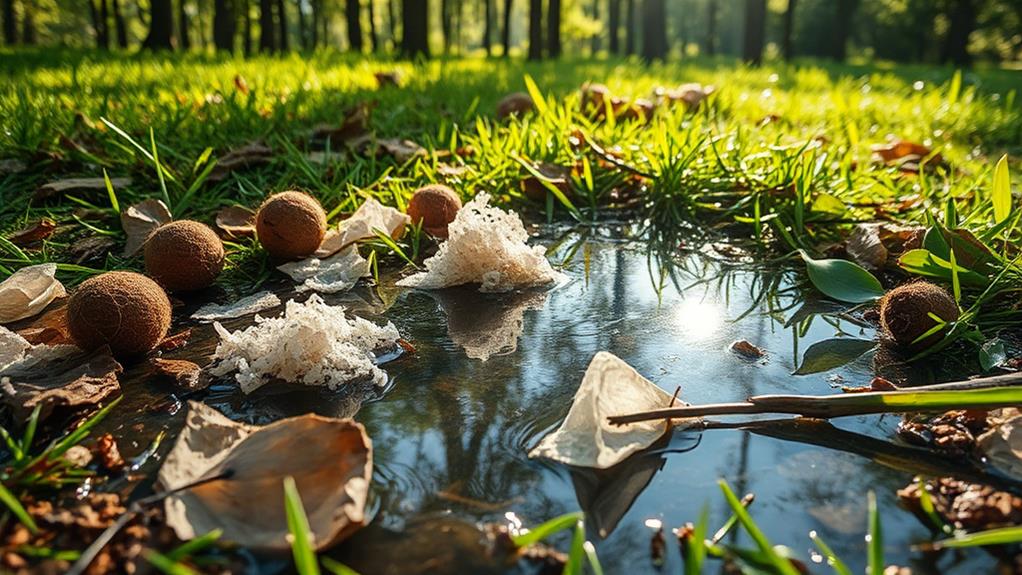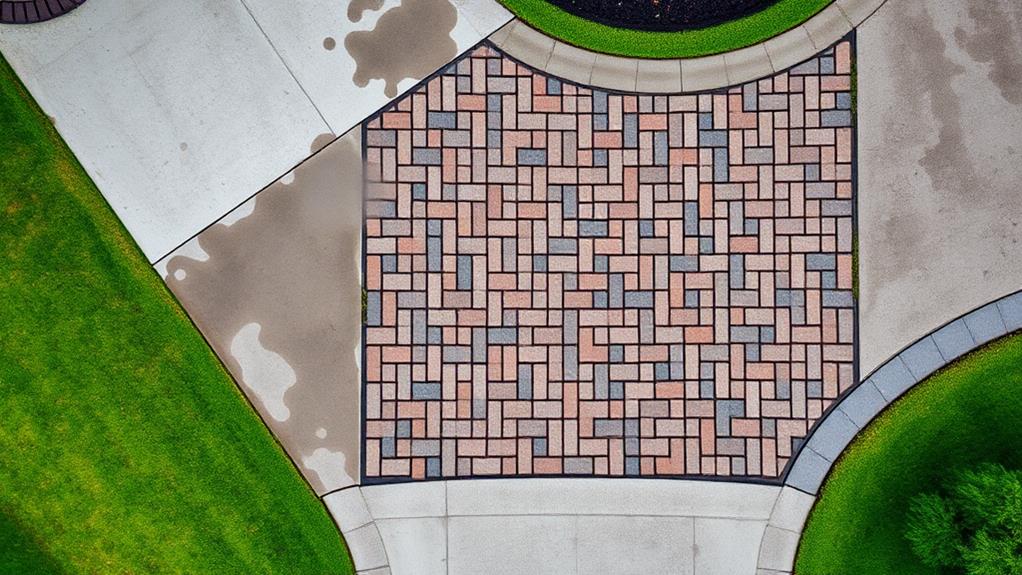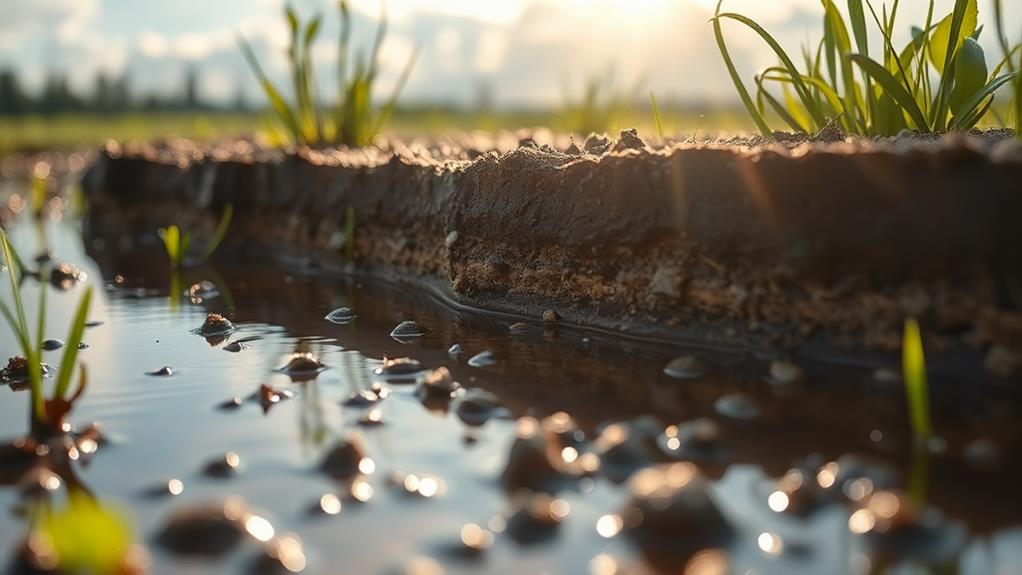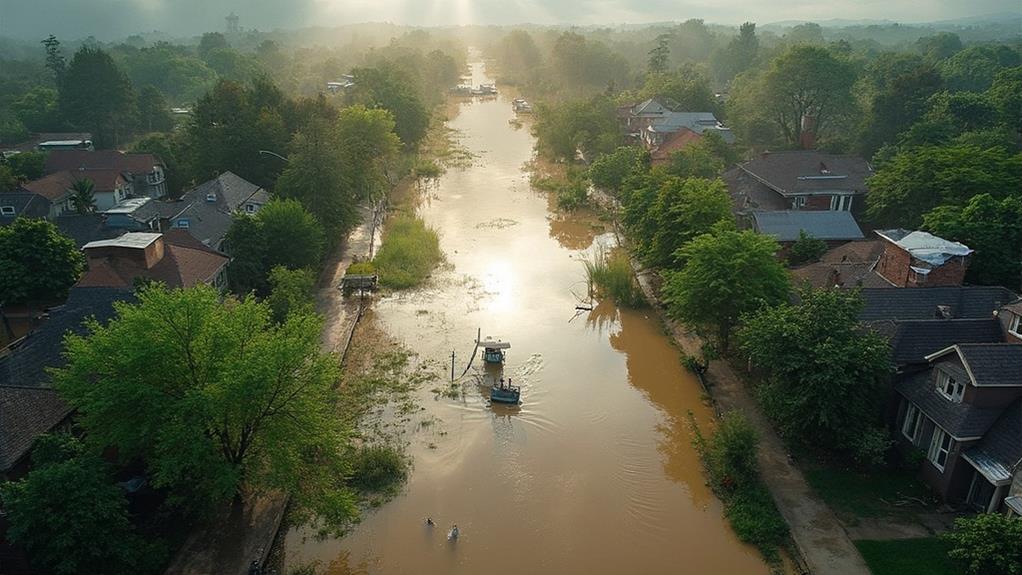Eco-friendly solutions for removing standing water post-storm include natural absorbent materials like straw, sawdust, and coconut coir. Bioswales and rain gardens offer landscaping options that manage stormwater while enhancing biodiversity. Permeable paving allows water to seep into the ground, reducing runoff and replenishing groundwater. Plant-based water pumps utilize trees and vegetation to absorb excess water naturally. Microbial remediation techniques, such as bioaugmentation and mycofiltration, effectively address standing water while contributing to soil health. These sustainable methods not only remove water but also provide additional environmental benefits. Exploring these options can lead to more comprehensive and long-term solutions for post-storm water management.
Natural Absorbent Materials

Among the eco-friendly solutions for removing standing water after a storm, natural absorbent materials stand out as highly effective and environmentally responsible options. These materials can quickly soak up excess water without introducing harmful chemicals into the environment. Common natural absorbents include straw, sawdust, wood chips, and coconut coir.
Straw is particularly effective due to its high absorption capacity and widespread availability. It can be easily spread over waterlogged areas and later collected for composting or mulching.
Sawdust and wood chips, byproducts of the lumber industry, offer similar benefits and can be repurposed for landscaping after use.
Coconut coir, derived from coconut husks, is an excellent absorbent material with the added advantage of being biodegradable and renewable. It can absorb up to eight times its weight in water and is resistant to bacterial growth, making it ideal for areas prone to standing water.
When using these materials, it's essential to distribute them evenly across affected areas and remove them promptly once they've absorbed the excess water. This prevents mold growth and ensures the area dries completely. Proper disposal or repurposing of the saturated materials completes the eco-friendly water removal process.
Bioswales and Rain Gardens
How can landscaping play a role in eco-friendly water management? Bioswales and rain gardens are innovative landscape features designed to capture, filter, and redirect stormwater runoff. These natural solutions help mitigate flooding and reduce the burden on municipal drainage systems while improving water quality.
Bioswales are shallow, vegetated channels that collect and convey stormwater. They typically feature native plants with deep root systems, which help filter pollutants and slow water flow. Bioswales can be integrated along roadsides, parking lots, and other paved areas to manage runoff effectively.
Rain gardens, on the other hand, are depressed areas in the landscape filled with deep-rooted native plants and sometimes gravel or sand. These gardens are strategically placed to collect rainwater from roofs, driveways, and other impervious surfaces. As water accumulates, it slowly infiltrates the soil, reducing erosion and recharging groundwater.
Both bioswales and rain gardens offer multiple benefits beyond water management. They enhance biodiversity, provide habitat for pollinators, and beautify urban environments. By incorporating these landscape features, property owners can contribute to sustainable stormwater management while creating attractive, low-maintenance outdoor spaces.
Permeable Paving Solutions

Another effective approach to eco-friendly water management involves the use of permeable paving solutions. These innovative materials allow water to seep through the surface and into the ground below, reducing runoff and preventing standing water accumulation. Permeable pavers come in various forms, including porous asphalt, pervious concrete, and interlocking pavers with gaps filled with small stones or vegetation.
These systems offer numerous benefits beyond water management. They help replenish groundwater, filter pollutants from stormwater, and reduce the urban heat island effect. Permeable pavements are particularly useful in parking lots, driveways, and low-traffic roads, where they can significantly decrease the burden on traditional drainage systems.
Implementation of permeable paving requires careful site assessment and proper installation to ensure optimal performance. Factors such as soil type, slope, and expected traffic load must be considered. Regular maintenance, including periodic cleaning to prevent clogging, is essential for long-term effectiveness. While initial costs may be higher than traditional paving, the long-term environmental and financial benefits often outweigh the investment, making permeable paving an attractive option for sustainable urban development.
Plant-Based Water Pumps
Harnessing the power of nature, plant-based water pumps offer an innovative and sustainable solution for removing standing water after storms. These systems utilize the natural processes of certain plants to absorb and transpire excess water from waterlogged areas.
One notable example is the use of willow trees, which can absorb up to 100 liters of water per day through their extensive root systems. By strategically planting these trees in flood-prone areas, they can significantly reduce standing water and mitigate flood risks. Similarly, species like cattails and bulrushes are highly effective at absorbing and filtering water in wetland environments.
Another plant-based approach involves the implementation of rain gardens, which are designed depressions filled with native, water-loving plants. These gardens can effectively capture and filter stormwater runoff, reducing the volume of standing water in surrounding areas.
Phytoremediation techniques, using plants like sunflowers and Indian mustard, can also help remove contaminants from standing water while simultaneously reducing its volume. These eco-friendly solutions not only address the immediate issue of standing water but also contribute to long-term environmental sustainability and improved water quality in affected areas.
Microbial Remediation Techniques

Several microbial remediation techniques offer effective and environmentally friendly solutions for addressing standing water issues after storms. These methods harness the natural abilities of microorganisms to break down contaminants and excess nutrients in waterlogged areas.
One prominent technique is bioaugmentation, which involves introducing specific bacteria or fungi to enhance the degradation of pollutants. These microbes can rapidly multiply and consume organic matter, reducing water levels and improving overall water quality.
Another approach is biostimulation, where nutrients or oxygen are added to the environment to boost the activity of existing beneficial microorganisms.
Mycofiltration utilizes fungi to filter and cleanse water, removing harmful pathogens and pollutants. This method can be particularly effective in treating stormwater runoff. Phytoremediation, while not strictly microbial, often works in conjunction with soil microorganisms to remove excess water and contaminants through plant uptake and transpiration.
These microbial remediation techniques not only help remove standing water but also contribute to soil health and ecosystem restoration. By leveraging natural processes, they offer sustainable, low-impact solutions for post-storm water management, reducing the need for chemical treatments or energy-intensive mechanical interventions.
Frequently Asked Questions
How Long Does Standing Water Typically Take to Evaporate Naturally?
The evaporation time for standing water varies greatly depending on factors such as temperature, humidity, wind, and water depth. It can take anywhere from a few hours to several weeks for standing water to evaporate naturally.
Can Standing Water Attract Mosquitoes and Other Pests?
Standing water can indeed attract mosquitoes and other pests. It provides an ideal breeding ground for mosquitoes, which lay their eggs in stagnant water. Additionally, it may draw other insects and potentially rodents seeking a water source.
What Are the Health Risks Associated With Prolonged Exposure to Standing Water?
Prolonged exposure to standing water poses significant health risks, including waterborne diseases, bacterial infections, and fungal growth. It can also lead to mold infestations, respiratory issues, and contamination of drinking water sources if not properly addressed.
Are There Any Government Programs That Assist With Standing Water Removal?
Several government programs assist with standing water removal. FEMA offers disaster assistance, while local health departments and emergency management agencies may provide resources. Some municipalities have specific programs for flood recovery and water removal services.
How Can I Prevent Standing Water Accumulation in My Yard During Future Storms?
Imagine your yard as a thirsty sponge, eager to absorb nature's bounty. To prevent standing water, consider:
- Improving drainage
- Installing rain gardens
- Using permeable paving
- Grading your landscape
- Planting water-loving vegetation
These strategies will help safeguard your property.
Conclusion
In conclusion, eco-friendly solutions for removing standing water post-storm offer multifaceted benefits. Natural absorbents, bioswales, permeable paving, plant-based pumps, and microbial remediation techniques provide sustainable alternatives to traditional methods. These approaches not only address immediate flooding concerns but also contribute to long-term environmental health. Like a well-oiled machine, these integrated solutions work in harmony to mitigate water accumulation, enhance soil quality, and promote biodiversity. Implementing such green strategies can significantly improve urban resilience and ecological balance in the face of increasingly frequent extreme weather events.

